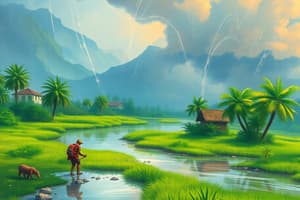Podcast
Questions and Answers
What major rivers in India are mentioned to frequently overflow during monsoons or high-water flow periods?
What major rivers in India are mentioned to frequently overflow during monsoons or high-water flow periods?
- Mississippi and Danube
- Nile and Amazon
- Ganges and Brahmaputra (correct)
- Amazon and Yangtze
Which region in India was severely affected by a devastating flood in September 2020?
Which region in India was severely affected by a devastating flood in September 2020?
- Goa
- Rajasthan
- Tamil Nadu
- Kerala (correct)
What natural disaster occurred in Uttarakhand in April 2013, leading to the loss of 154 lives?
What natural disaster occurred in Uttarakhand in April 2013, leading to the loss of 154 lives?
- Drought
- Earthquake
- Cyclone
- Landslides (correct)
How do warmer seas impact cyclones according to the text?
How do warmer seas impact cyclones according to the text?
What event registered a magnitude of 7.7 on the Richter scale, leading to around 20,000 fatalities?
What event registered a magnitude of 7.7 on the Richter scale, leading to around 20,000 fatalities?
What is the range of temperature variations mentioned in the text?
What is the range of temperature variations mentioned in the text?
Which climatic feature is crucial for India's agriculture and water availability?
Which climatic feature is crucial for India's agriculture and water availability?
What can deviations from the normal monsoon cycle result in?
What can deviations from the normal monsoon cycle result in?
Which region in India experiences an annual mean minimum temperature of -3°C?
Which region in India experiences an annual mean minimum temperature of -3°C?
What contributes to the ecological challenges and health hazards mentioned in the text?
What contributes to the ecological challenges and health hazards mentioned in the text?
Flashcards are hidden until you start studying
Study Notes
Climate of India: Navigating Weather Diversity and Change
India's unique geography spans four major climatic zones, from arid deserts to snowy mountains, all while standing at the forefront of global concerns regarding climate change. To understand this complex climate system, let's delve into its intricate dynamics—temperature fluctuations, weather patterns, monsoons, and their impactful consequences.
Temperature Variations
From an annual mean minimum temperature of -3°C in Dras Valley, Ladakh, to a maximum reaching 47°C in Alwar, Rajasthan, India experiences some of the largest temperature swings globally. These extreme temperatures contribute to ecological challenges and health hazards, especially during heatwaves and cold snaps.
Rainfall Patterns & Monsoon Season
Rainfall is one of India's most defining features; much of the country depends upon the Southwest Monsoon between June–September. Over 80% of rainfall occurs during these months due to favorable conditions over the Indian Ocean, resulting in moisture carrying winds traveling across southern India. This predictable yet unpredictable cycle plays a pivotal role in agriculture and water availability, with deviations causing significant regional impacts.
Monsoons also bring heavy precipitation leading to frequent flooding events, landslides, and droughts if they fail to reach certain regions. For instance, almost 90 million people suffered flooding after record-breaking monsoonal rains hit Kerala in August 2018. Conversely, deficient monsoons led to severe agricultural losses and acute water shortages, such as occurring in Maharashtra in 2019.
Natural Disasters and Extreme Events
With diverse topographies and changing climate patterns, India experiences various forms of natural calamities, including floods, cyclones, earthquakes, landslides, and drought.
Floods: Major rivers like Ganges, Brahmaputra, Godavari, Kaveri, Cauvery, Yamuna, and Kosi often overflow their banks during monsoons or regular high water flow periods. Inadequate drainage systems exacerbate flood risks, sometimes leaving millions displaced and requiring emergency relief efforts. Recent examples include the devastating floods in Bihar and Assam in July and September 2020, respectively.
Earthquakes: Although less common than other disasters, earthquakes do occur, primarily along Himalayan fault lines and in northern India near major tectonic plates. A notable example was the Gujarat Earthquake in January 2001, registering a magnitude of 7.7 on the Richter scale, killing around 20,000 individuals.
Landslides: Landslides happen frequently throughout mountainous regions due to heavy monsoon rains and seismic activity. One of the deadliest occurred in April 2013 when 154 lives were lost following massive landslides triggered by a storm in Uttarakhand.
Droughts: Periods without adequate rainfall lead to widespread crop failure, groundwater depletion, and livelihood loss, particularly affecting rural areas where agriculture serves as a primary source of income. An extensive drought in Marathwada region affected more than half a million farmers, culminating in mass suicides among indebted farmers in 2015.
Impacts of Climate Change
Indian scientists have been observing the effects of anthropogenically driven climate change since the early 1990s. Changing temperature regimes affect ocean currents, weather patterns, and ecosystems, intensifying existing issues and creating new ones. Some implications include:
Altered monsoon behavior: Changes in monsoon patterns could result in erratic rainfall distribution, prolonged droughts, flash flooding, and erosion events.
Acidity in oceans: Increased sea surface temperatures cause ocean acidification, threatening marine life, coral reefs, and traditional fisheries.
Increasing ocean temperatures: Warmer seas augment cyclone intensity, posing threats to coastal cities and infrastructure.
Climate adaptation initiatives targeted at improving infrastructure resilience, enhancing sustainable farming practices, preventing soil erosion, developing early warning systems, promoting disaster risk reduction strategies, and building community awareness will play critical roles in mitigating the detrimental effects of climate change on India's environment and economy.
Studying That Suits You
Use AI to generate personalized quizzes and flashcards to suit your learning preferences.




